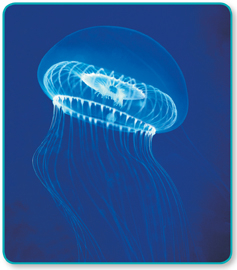Finding Genes In 1987, Douglas Prasher, a biologist at Woods Hole Oceanographic Institute in Massachusetts, wanted to find a specific gene in a jellyfish. The gene he hoped to identify is the one that codes for a molecule called green fluorescent protein, or GFP. This natural protein, found in the jellyfish shown in Figure 15–5, absorbs energy from light and makes parts of the jellyfish glow. Prasher thought that GFP from the jellyfish could be used to report when a protein was being made in a cell. If he could somehow link GFP to a specific protein, it would be a bit like attaching a light bulb to that molecule.

FIGURE 15–5 A Fluorescent Gene The Pacific Ocean jellyfish, Aequoria victoria, emits a bluish glow. A protein in the jellyfish absorbs the blue light and produces green fluorescence. This protein, called GFP, is now widely used in genetic engineering.
To find the GFP gene, Prasher studied the amino acid sequence of part of the GFP protein. By comparing this sequence to a genetic code table, he was able to predict a probable mRNA base sequence that would have coded for this sequence of amino acids. Next, Prasher used a complementary base sequence to “attract” an mRNA that matched his prediction and would bind to that sequence by base pairing. After screening a genetic “library” with thousands of different mRNA sequences from the jellyfish, he found one that bound perfectly.
After Prasher located the mRNA that produced GFP, he set out to find the actual gene. Taking a gel in which restriction fragments from the jellyfish genome had been separated, he found that one of the fragments bound tightly to the mRNA. That fragment contained the actual gene for GFP, which is now widely used to label proteins in living cells. The method he used, shown in Figure 15–6, is called Southern blotting. Today it is often quicker and less expensive for scientists to search for genes in computer databases where the complete genomes of many organisms are available.

FIGURE 15–6 Southern Blotting Southern blot analysis, named after its inventor Edwin Southern, is a research technique for finding specific DNA sequences, among dozens. A labeled piece of nucleic acid serves as a probe among the DNA fragments.
ddTable of Contents
- Formulas and Equations
- Applying Formulas and Equations
- Mean, Median, and Mode
- Estimation
- Using Measurements in Calculations
- Effects of Measurement Errors
- Accuracy
- Precision
- Comparing Accuracy and Precision
- Significant Figures
- Calculating With Significant Figures
- Scientific Notation
- Calculating With Scientific Notation
- Dimensional Analysis
- Applying Dimensional Analysis




